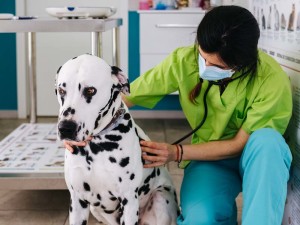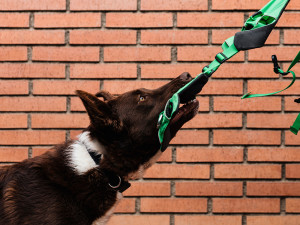How to Tell if Your Dog Is in Pain
And what to do to help them.

Share Article
In This Article:
Signs Your Dog Might Be in Pain Common Causes of Pain in Dogs How to Diagnose Pain in Dogs Safe Pain Relief Options for Dogs When to Consult a Vet
Is your dog whimpering? Do they seem like they’re in distress? Are they acting tired, despite having just napped all day? They may just be acting a little wacky (dogs, like people, are known to do that from time to time). But they may also be in pain. Here are things to look for if you think that may be the case.
Signs your dog might be in pain
Pain in dogs can be obvious or subtle. A common phone call that veterinary offices receive goes something like this: “I’m worried that my dog is in pain.” He’s eating and drinking, but he just seems down and isn’t acting like himself. I don’t know how to tell where my dog is painful, and I don't want to hurt him trying to find out.”
Figuring out if and where your dog hurts can be difficult, even for vets. In my experience, dogs try to hide their signs of pain, especially when they’re anxious or afraid. This can make localizing pain a challenge during visits to the vet clinic, but veterinarians can often spot subtle indicators of pain even in stoic dogs. If you’re not sure if your dog is in pain, look for some indicators like:

Routine changes
You know what your dog’s “normal” looks like: their ritual around pooping and peeing, which beds they like to lay in, if they curl up or stretch out, and how much they follow you around from room to room. Pain can disrupt their routine, so any behavior that’s out of the norm should raise a red flag. Even small things like not jumping on the couch, not crunching on food like usual, or not begging for snacks can indicate a problem.
Decreased activity and withdrawal from people and other pets are common signs of pain in dogs. Dogs who are hurting don’t want to be jostled or made to move around, so they’ll often hide away to be left in peace. This means that pain or discomfort should be a top concern when you find your dog tucked away in a closet or under a bed. Unless they just won’t budge, don’t try to force your dog to relocate by pulling them or picking them up — coax them with a favorite treat or toy instead. This allows your dog to move at their own pace and in a way that minimizes pain.
Vocalization
We’ve all heard our dogs sigh like the weight of the world is on their shoulders. I’m sure laying around all day, investigating interesting smells, and monitoring squirrel activity are all very taxing, but the discontented grumbles can be a little much for a family member that doesn’t help pay the bills. Painful dogs often make sounds that go beyond their normal world-weary exhalations. Dogs may try to communicate pain by whining, growling, yipping, or barking.
Some painful dogs make a constant, high-pitched whine or whimper, while others only vocalize when they anticipate pain or have a sudden spike of pain. Growling can be a warning that you’re approaching a painful area. It’s best not to force the issue and back off. Even the friendliest dogs can lash out when they’re in pain.
Physical symptoms
Some of the more obvious signs of pain in a dog are limping and difficulty walking. Limps can be obvious (holding a leg up all the time) or subtle (a head bob when putting weight on the painful limb). It’s very common for pet parents to recognize that their dog’s gait is off but not know exactly what leg is causing the problem. It’s not always easy for vets either. I’ve definitely had to watch dogs with a mild limp walk up and down a hallway multiple times to figure out where the problem is.
Other physical symptoms of pain can include trembling, changes in posture, and stiffness. Trembling is easy to pick up on and is often accompanied by a woe-is-me facial expression. Changes in posture may not always be obvious, but some common signs include:
Putting less weight on one limb when standing still
Arched back
Low head carriage
Neck turned to one side
A dog in pain will often appear very stiff and slow to move. This is especially common with back and abdominal pain.
Guarding behavior
Painful dogs should be approached with caution because they will guard painful areas. Even though you’re trying to help, your dog may not perceive you reaching for their ouch-y area as an attempt at aid. Dogs will often try to move painful areas out of your reach, curling away from contact and the risk of more pain. They may even growl or raise their hackles to give a warning that they don’t appreciate your attempts at assisting them.
Common causes of pain in dogs
Dogs can be painful for many reasons. Sometimes you’ll know the cause immediately because you witnessed your dog run headfirst into a trailer hitch while fetching a ball. Sometimes signs of pain take a while to show up, and you have to think back to what you did yesterday to figure out what could have caused it. Other times, there’s no obvious trigger and you’re just stuck with a mystery.
When I’m presented with a dog that seems painful, I think about a few common causes, such as:
Orthopedic injuries: sprains, strains, fractures
Dental pain: fractured teeth, dental infections
Spinal pain: ruptured discs, meningitis
Infections: ear infections, urinary tract infections, abscesses
Chronic conditions: arthritis, lumbosacral disease, cancer
Gastrointestinal conditions: intestinal foreign bodies, pancreatitis, bloating, constipation
Wounds: Cuts, scrapes, broken toenails
How to diagnose pain in dogs
It can be tempting to try to figure out why your dog is in pain at home. While it may give you a clue about the cause, you shouldn’t push it if your dog is giving you warning signs that they’re not up for the process. One big benefit of visiting your vet is that they have injectable pain medications available that can make your dog less stressed and more comfortable quickly.
If your dog allows it, you can do a gentle once-over at home to see if there’s an obvious, fixable cause for their pain. Sometimes you’ll find an acorn shell lodged between their foot pads and get to be your dog’s savior for the day. Being calm, systematic, and intentional in your approach can help put your dog at ease and make things easier for you. Steps to figuring out if your dog is in pain and where the pain is coming from include:
Observe your dog’s routine.
Note changes in your dog’s eating, drinking, or bathroom habits. Is your dog suddenly squatting when they're usually a leg lifter? Are they slow to get up or lay down? Do they hesitate to jump on the couch or hop up for attention? Are they able to lay in their usual place and position?
Answering all of these questions can help tell you if your dog is in pain, but it probably won’t give you a definitive answer. Some dogs with these symptoms may have a systemic disease that causes general malaise that can look similar to signs of pain.
Conduct a basic physical check.
Finding the source of discomfort can confirm that your dog is truly in pain, but it comes with some risks. Localizing pain often involves touching or moving the painful area. This can sometimes provoke aggressive reactions or cause your dog to be afraid of you. It’s fine if you’re not feeling up to examining your dog for painful areas; no one wants to cause their canine companion pain. I recently took my own dog to see another veterinarian when he was showing signs of spinal pain — I suspected his back hurt, but didn’t want to be the one to poke and prod to find out for sure.
If you’re feeling brave and your dog is tolerant, you can try to do a basic examination to check for obvious causes of pain. Look for cuts, discharge, blood, swollen areas, and obvious injuries. Run your hands gently over your dog’s limbs, back, neck, abdomen, and chest to feel for warm spots, lumps, or tender areas. If your dog is limping, check their feet for foreign objects stuck between their toes.
Visit a veterinarian.
If you’re concerned your dog is in pain and either don’t feel comfortable or are unable to find the source of pain, see your vet. Your vet can examine your dog fully to check for common causes of pain, give them pain medications if needed, and do additional diagnostics like radiographs (X-rays) to determine why your dog is in pain.
Safe pain-relief options for dogs
Whether you find the exact cause of your dog’s pain or not, getting the pain under control is a priority. Don’t rush to give your dog the same medications you take for pain though. Dogs can’t handle many common human pain medications and can even develop significant problems if they’re given. Some safe pain relief options for dogs include:
Injectable medications
These medications would be administered by your vet during an office visit. Depending on your dog’s level of pain, they can include narcotics like butorphanol and hydromorphone or initial doses of non-steroidal anti-inflammatory drugs (NSAIDs) like carprofen.
Prescribed medications
Your veterinarian may prescribe an oral NSAID like carprofen, meloxicam, or grapiprant to help relieve pain. These drugs are commonly used for orthopedic conditions and back pain, but they may not be safe for dogs with certain liver or kidney issues. Alternative drugs may be prescribed instead of or in addition to NSAIDs. Drugs like gabapentin and tramadol have less evidence supporting their effectiveness in dogs but are generally considered safe options.
Natural pain relief alternatives
Supplements like glucosamine and chondroitin sulfate for joint health may help with the progression of the chronic pain of arthritis, but don’t do anything for acute pain. Once the source of your dog’s pain is found, your veterinarian may recommend holistic pain relief therapy including physical therapy, massage, or acupuncture. For many acutely painful orthopedic conditions, activity restriction is a major part of recovery. Keeping calm and rested is easier for some dogs than others.
Medications to avoid
Avoid giving dogs over-the-counter pain medications, including drugs like “doggie aspirin” that are marketed for pets. Dogs have a significant risk of developing stomach ulcers, kidney injury, or liver issues when taking these drugs. Reaching for these medications will likely do more harm than good, and giving them can cause drug interactions that limit the safe, effective options available for your dog. Acetaminophen may be used for dogs under veterinary guidance in some situations, but the dose and risks need to be calculated precisely.
When to consult a vet
It’s sometimes tough to know when your dog is being dramatic and when a vet visit would really help them. For dogs that have mild signs of pain like a slight lameness, watchful waiting for a day or two can be OK, provided they’re not showing any other symptoms. Always take your dog to the vet for a consult if you’re concerned about them, or if they’re showing any of these signs:
Obvious deformities (fractures, dislocations)
Open wounds
Not putting weight on a limb
Inability to walk
Mild pain that’s worsening or not resolving after a couple of days of rest
Not wanting to get up
Decreased appetite or thirst
Unsteady gait
Sudden changes in behavior
Seizures
Aggression
Frequent vocalization
Heavy breathing
Abdominal pain or swelling
Inability to urinate or defecate
Bottom line
Symptoms of pain can be subtle in dogs, but observing their behavior and routines can help you recognize the signs. If your dog allows it, you can try to find the source of pain at home, but the best bet is usually to have your vet check for problems. Whatever you do, don’t ignore persistent, worsening, or moderate-to-severe pain — get your dog to the vet, so they can start feeling better quickly.
References
Demirtas, Ahu, et al. “Dog Owners’ Recognition of Pain-Related Behavioral Changes in Their Dogs.” Journal of Veterinary Behavior, vol. 62, 1 Apr. 2023, pp. 39–46, www.sciencedirect.com/science/article/pii/S1558787823000345opens in new tab, https://doi.org/10.1016/j.jveb.2023.02.006opens in new tab.
Gruen, Margaret E., et al. “2022 AAHA Pain Management Guidelines for Dogs and Cats.” Journal of the American Animal Hospital Association, vol. 58, no. 2, 23 Feb. 2022, pp. 55–76, https://doi.org/10.5326/jaaha-ms-7292opens in new tab.
Harari, Joseph. “Pain Management in Small Animals with Lameness.” MSD Veterinary Manual, 8 June 2021, www.msdvetmanual.com/musculoskeletal-system/lameness-in-small-animals/pain-management-in-small-animals-with-lamenessopens in new tab. Accessed 30 Dec. 2024.

Dr. Bartley Harrison, DVM
Dr. Bartley Harrison is a veterinarian with more than 19 years of experience. He has treated a variety of species in emergency and speciality practices for both large and small animals. His primary interests as a vet are emergency medicine and critical care.
Related articles
![Dalmatian and Great Dane mixed dog at the vet being checked on by a nurse in bright green scrubs]()
Why Is Your Dog’s Stomach Hard? What to Give a Bloated Dog
And when to be concerned.
![Dog is biting his dog harness to take the dog for a walk]()
Nobody Likes to Be Labeled — Especially Your Dog
(Mis)labeling behaviors does more harm than good.
![Dog with sleep startle reflex. Woman lays on her couch and gently wakes up her dog]()
Why Does My Dog Freak Out When I Wake Them Up?
“Let sleeping dogs lie” is more than just a confusing old saying.
Do Dogs Understand Our Words?
Say What? A look at the types of words that dogs understand.
![Jack Russell puppy grunting while laying on blanket and crying out]()
Listen Up! Your Puppy Is Trying to Talk to You
How to make sense of all those grunts and whines.
![Brown Labrador lifting front leg]()
How to Get a Head Start on Your Pet’s Health
Spot lumps, limps, and lethargy early on.








